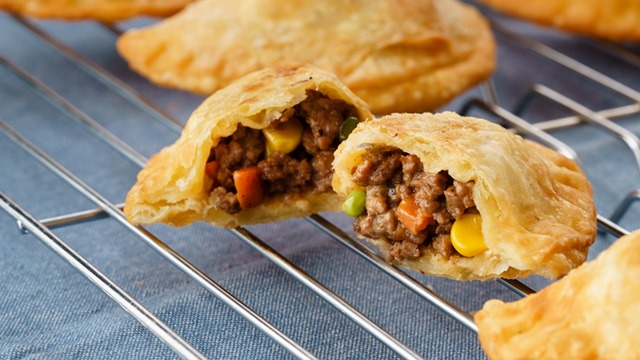Empanadas are a beloved culinary delight with origins in Latin America, but they have found their way into kitchens worldwide. These delectable pastries can be filled with various ingredients, making them versatile and suitable for any palate.
Whether you prefer your empanadas baked or fried, filled with meat or vegetables, knowing the right techniques and tips can elevate your empanada-making skills. In this comprehensive guide, we’ll explore the intricacies of empanada cooking techniques, from baking vs. frying to the best fillings and essential tools.

Empanada Cooking Techniques: Baking vs. Frying
Choosing between baking and frying your empanadas is a significant decision that affects both taste and texture. Each method has its unique characteristics, and understanding the pros and cons of each can help you achieve the perfect empanada.
Pros and Cons of Baking
Baking empanadas is a popular method that offers several benefits:

Pros:
- Healthier Option: Baking requires less oil, resulting in fewer calories and less fat, making it a healthier choice.
- Consistent Cooking: Baking ensures that the empanadas cook evenly, reducing the risk of undercooked centers.
- Convenience: You can bake a large batch of empanadas at once, making it ideal for serving many people.
Cons:
- Crispiness: Baked empanadas might lack the crispiness that frying provides.
- Flavor Profile: Baking may not impart the same depth of flavor as frying due to the absence of oil.
Pros and Cons of Frying
Frying is a traditional method that many empanada enthusiasts swear by for its distinctive taste and texture:

Pros:
- Crispy Texture: Frying results in a golden, crispy exterior that many people find irresistible.
- Enhanced Flavor: The oil used in frying can add a rich, savory flavor to the empanadas.
Cons:
- Health Considerations: Frying significantly increases the calorie and fat content of the empanadas.
- Time and Effort: Frying can be more labor-intensive and requires constant attention to avoid burning.
Best Fillings for Empanadas
The filling is the heart of any empanada, and choosing the right ingredients can make all the difference. Here, we’ll explore some of the best meat and vegetarian fillings for making the ultimate empanada dish.
Meat Fillings
Meat-filled empanadas are a classic favorite, offering robust flavors and satisfying textures:

- Beef: A traditional choice, often seasoned with onions, garlic, cumin, and paprika. Ground beef or finely chopped steak works well.
- Chicken: Shredded chicken mixed with peppers, onions, and spices creates a delicious filling. Adding olives or raisins can introduce a sweet and savory balance.
- Pork: Slow-cooked pork, seasoned with a blend of spices, makes for a succulent filling. Pulled pork or chorizo are popular options.
Vegetarian Fillings
Vegetarian empanadas can be just as flavorful and hearty as their meat counterparts:
- Cheese and Spinach: A classic combination, featuring melted cheese and sautéed spinach. Adding nutmeg can enhance the flavor.
- Mushroom and Onion: Sautéed mushrooms and caramelized onions create a rich, umami-filled filling. Adding thyme or rosemary can elevate the taste.
- Corn and Cheese: Sweet corn mixed with creamy cheese offers a delightful contrast. A hint of chili powder can add a subtle kick.

How to Store and Reheat Empanadas
Proper storage and reheating techniques ensure that your empanadas remain delicious even after a few days. Here are some tips for keeping your empanadas fresh.
Storage Tips
- Refrigeration: Store cooked empanadas in an airtight container in the refrigerator. They can last for up to 3-4 days.
- Freezing: To freeze empanadas, place them on a baking sheet in a single layer and freeze until solid. Then, transfer them to a freezer bag or container. Frozen empanadas can last for up to three months.

Reheating Methods
- Oven: Reheat empanadas in a preheated oven at 350°F (175°C) for about 10-15 minutes or until heated through. This method helps maintain their crispiness.
- Microwave: For a quicker option, reheat empanadas in the microwave for 1-2 minutes. However, this can make them less crispy.
- Stovetop: Heat a skillet over medium heat and warm the empanadas for a few minutes on each side. This method helps retain some of the crispiness.

Tools and Equipment for Making Empanadas
Having the right tools and equipment can streamline the empanada-making process and improve your results. Here are some essential and specialty tools to consider.
Essential Tools
- Rolling Pin: A good rolling pin is crucial for rolling out the dough evenly.
- Empanada Press: This tool helps shape and seal the empanadas quickly and efficiently.
- Baking Sheets: Use sturdy baking sheets for baking empanadas to ensure even cooking.

Specialty Equipment

- Deep Fryer: If you prefer frying, a deep fryer can provide more consistent results than a skillet.
- Pastry Brush: Use a pastry brush to apply egg wash to the empanadas for a golden, shiny crust.
- Cooling Rack: Allow baked or fried empanadas to cool on a rack to prevent them from becoming soggy.
FAQs
Conclusion
Mastering empanada cooking techniques can transform your kitchen into a haven of delicious pastries, whether you prefer them baked or fried. With the right fillings, proper storage, and essential tools, you can create empanadas that delight your taste buds and impress your guests. Explore the world of empanadas and enjoy the endless possibilities these delightful pastries offer.

Disclosure: Our blog contains affiliate links to products. We may receive a commission for purchases made through these links. However, this does not impact our reviews and comparisons. We try our best to keep things fair and balanced, in order to help you make the best choice for you.








One Comment